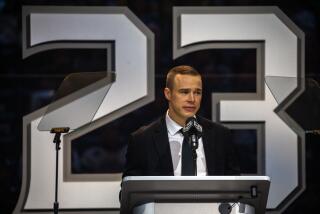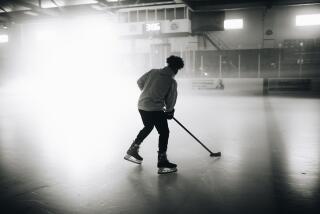Taunts Never Stopped for Willie O’Ree
- Share via
In the days when the NHL was a six-team, all-white operation, Willie O’Ree was the ultimate long shot--the league’s first black player. And he was reminded of it every time he stepped on the ice.
Perhaps encouraged by the success of integration in baseball, basketball and football, the NHL in 1958 became the last major sport to sign a player of color.
O’Ree was a successful junior hockey player when the call came from a couple of Hall or Famers who were running the Boston Bruins. “Milt Schmidt and Lynn Patrick said, ‘We feel you can handle this,”’ O’Ree said.
They were right about the hockey part. The rest of it was more difficult.
“I felt like a lone eagle,” said O’Ree, the NHL’s director of youth development, running clinics for children. “I was ready to an extent, but I didn’t know how far I’d have to go. I wasn’t going to be run out. I knew I’d get hit. I wasn’t ready for some of what happened.”
In an all-white environment, O’Ree was constantly reminded of his heritage.
“I heard it every game,” he said. “I was no stranger to Montreal or Toronto fans. I had played junior in both cities. In New York, Chicago and Detroit, I ran into some problems. I wanted to be treated like just another hockey player, a player with skills and ability.
“I fought a lot. I had to because there were a lot of cheap shots.”
One night in Chicago, O’Ree lost two front teeth courtesy of the butt end of Eric Nesterenko’s stick, who was an equal opportunity tough guy.
“He laughed and made a racial remark,” O’Ree said. “The butt end made me go at him. I wound up with 22 stitches. I wanted to go back on the ice, but they said I’d better not. I needed a police escort to get out of the building.”
The next time the Bruins played the Blackhawks, Nesterenko greeted the newcomer with a two-hander across the ankles--in warmups, before the puck was ever dropped in anger. O’Ree still is a little disgusted by the whole affair.
Listening to all this was Kevin Weekes, the talented young goalie of the New York Islanders and one of about two dozen blacks who play in the NHL.
Weekes shook his head.
“Players have more respect for one another now,” he said. “It’s a tough league. His stuff sounds like it was personal.”
O’Ree played 45 games in two seasons for the Bruins, a blip in a 21-year pro hockey career, most of it spent in the Western League with the Los Angeles Blades and San Diego Gulls. When he left the NHL in 1961, it took 13 years before Mike Marson showed up to become the league’s next black player.
Now it’s no big deal. Black players have fit in seamlessly around the league: Weekes with the Islanders, Mike Grier with Edmonton, Anson Carter with Boston, Peter Worrell with Florida, and Fred Brathwaite with Calgary.
“The more that come, the more beneficial it will be,” O’Ree said. “A lot of whites never played against or rubbed shoulders with them.”
“Everything happens in time,” Weekes said. “Certain things can’t be rushed. We’ll see more and more as time goes on.”
O’Ree was the first black in the NHL, but maybe he shouldn’t have been.
“Herbie Carnegie was the one,” O’Ree said, pronouncing the name with reverence. “It should have been Herbie.”
Now Weekes looked up.
“I met him once,” the goalie said. “I went to see him. I wanted to spend an hour or so and I wound up spending a whole day with him.”
Carnegie was a talented player, part of an all-black semipro line in the 1940s with his brother, Ossie, and Marty McIntyre.
Any one of them might have been good enough to play in the NHL, except for one small problem. It was a less enlightened time in sports and black players were not yet welcome.
When Conn Smythe was running the Toronto Maple Leafs, he heard about Carnegie and watched him skate one day. His reaction was succinct.
“If I could turn Herbie white, he’d be with us,” Smythe said.
Carnegie, however, remained black, barred from the league that O’Ree would integrate a decade or so later.
More to Read
Go beyond the scoreboard
Get the latest on L.A.'s teams in the daily Sports Report newsletter.
You may occasionally receive promotional content from the Los Angeles Times.






